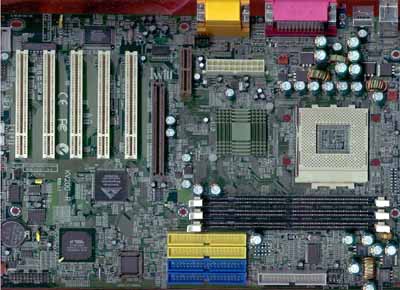
Original Link: https://www.anandtech.com/show/629
Iwill KV200-R Socket-A KT133 ATX
by Henry Kuo on October 4, 2000 12:58 AM EST- Posted in
- Motherboards
In spite of their fairly popular Aladdin V based XA-100 motherboard, Iwill has been pretty faithful to producing Intel boards. The company has been unusually absent from the Athlon motherboard scene as of late. They did not release any motherboards using the AMD 750 (Irongate) chipset nor a single board using the VIA KX133 chipset.
However, that has all changed. As we noted in our Computex 2000 coverage, the lack of any desirable chipsets from Intel left many motherboard manufacturers turning to VIA and AMD for solutions. Also during our visit to Taipei we took a look at Iwill’s upcoming lineup which, not to our surprise, consisted of quite a few VIA based solutions, including their first Athlon board.
With no prior experience in Athlon motherboard production, and also as a new “contestant” in the Socket-A motherboard market, can Iwill provide a Socket-A motherboard that is reliable and has the features that can allow it to compete with the ABITs and ASUSes of the industry? Let’s find out as we take a look at Iwill’s first attempt at an Athlon/Duron motherboard, the KV200-R.
|
Iwill KV200-R |
|
|
CPU
Interface
|
Socket-A
|
|
Chipset
|
VIA
KT133
|
|
Form
Factor
|
ATX
|
|
Bus
Speeds
|
100
– 166MHz (1MHz increments)
|
|
Voltages
Supported
|
Auto Detect
|
|
Memory
Slots
|
3
168-pin DIMM Slots
|
|
Expansion
Slots
|
1
AGP Slot |
|
On-board
Audio
|
C-Media
CMI-8738 3D 4.1 Hardware Sound
|
|
BIOS
|
Award
Modular BIOS 6.00PG
|
The Good
Compared to other KT133 motherboards, the Iwill KV200-R actually uses a smaller PCB, about 12” by 9”. This is good news since using a smaller PCB design can generally reduce the production costs of the motherboard, which is reflected in the final retail price. This is also why the first impression you get upon examining the board is that it has a very “busy” layout courtesy of the closely routed traces that are visible on the topmost PCB layer.
The power supply connector is next to the serial / parallel ports and a bit left of the CPU socket. This means that you will have to run your ATX power cable over the memory and the CPU, potentially cluttering the case with cables. So far from what we have seen the best place to place the power supply connector is the right edge of the PCB, where it will be directly under the power supply inside the case, so the cables do not have to run over the CPU and memory banks.
To the left of the 462-pin Socket-A interface, sits the VIA 371 North Bridge which is the core of the KT133 chipset. It provides home to all of the major features of the KT133 chipset, including the 133Mhz memory bus and AGP 4X support. The AGP slot is a “universal slot,” which means it is not keyed specifically for AGP 2X or AGP 4X cards, so the user can install almost any current AGP card in the slot. We have yet to see a KT133 motherboard implement any other type of AGP slot (other than an AGP Pro slot) which makes this much less of a feature and more of an observation common to all Socket-A boards.
Similar to other KT133 motherboards, the 8373 memory controller in the KV200-R is nice enough to let you run your memory at either 133MHz or 100MHz. Therefore, users with PC133 SDRAM can take advantage of the increased bandwidth over PC100 SDRAM, going from 800MB/s to 1.06GB/s. This can be done easily in the BIOS by setting the memory bus to +33MHz. It also allows PC100 SDRAM owners to continue to use their memory by leaving the memory bus at 100MHz while taking the performance hit associated with the decrease in memory bandwidth.
Generally, in order to maintain high levels of stability for the system, motherboard manufacturers put as many high quality capacitors as possible around the CPU socket. This guarantees sufficient power for the CPU and clean signals going in and out of the CPU. The KV200-R features six 2200uF and seven 1500uF capacitors around the 462-pin Socket-A interface. Some of the capacitors are a bit close to the socket which can be a problem for users that are attempting to install some of the larger heatsink/fan combos that are being used on Athlons so be very careful.
The 5/1/1/0 (PCI/AGP/AMR/ISA) expansion slot configuration on the KV200-R should be enough for most users. One thing we noticed is that the AMR slot is not shared, so it seems that Iwill targets this motherboard for the OEM market. However with the relative lack of any adaptation of the AMR specification in the actual production of AMR cards, we see Iwill’s failure to provide the AMR slot as a shared slot, a waste of PCB space. This is because of the fact that in order to keep the AMR slot as a separate slot, Iwill gives up a PCI / ISA slot. Since the VIA 686A “Super” South Bridge supports up to 5 PCI slots and also features an integrated PCI-ISA bridge, Iwill could have included another PCI or ISA slot. Now the AMR slot takes away one of them, and that is bad news for users with many PCI devices or users who have ISA modems or old ISA SCSI controllers for tape drives that they were planning on using.
The VIA 686A South Bridge also supports up to 4 USB devices. Beside the two traditional USB ports mounted at the back of the motherboard together with the serial / parallel ports, there is also a connector for USB 3 and 4 on the left edge of the board. However, Iwill, like most other manufacturers (other than ASUS), fails to include any USB headers to take advantage of the extra two USB connectors.
The VIA 686A South Bridge provides two IDE channels that are both ATA-66 ready. These channels still support ATA-33 devices, so users can still use their CDROMs and ATA-33 hard drives, but they do allow users to attach a total of 4 ATA-66 IDE devices.
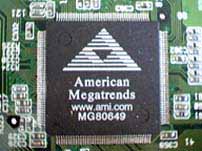 Just
like the ABIT did with their KT7-RAID, Iwill also added in an ATA-100 RAID controller
on the KV200-R. The controller they use is made by one of the biggest names
when it comes to RAID, American Megatrends. The American Megatrends HG80649
controller supports 2 ATA-100 channels, which means users can connect up to
4 ATA-100 devices. Although as of now, there are no IDE drives that feature
sustained transfer rates higher than 40MB/s, this is still a good preparation
for future generations of IDE devices. Like the HighPoint controller on the
ABIT, the AMI IDE RAID controller on the KV200-R supports RAID 0, 1, and 0+1
functions, which are the most popular options nowadays. The absence of RAID
5 support is another indicator that while IDE RAID may be an interesting arena
to toy in, it is still far from the level of performance and especially reliability
of hardware SCSI RAID 5 solutions.
Just
like the ABIT did with their KT7-RAID, Iwill also added in an ATA-100 RAID controller
on the KV200-R. The controller they use is made by one of the biggest names
when it comes to RAID, American Megatrends. The American Megatrends HG80649
controller supports 2 ATA-100 channels, which means users can connect up to
4 ATA-100 devices. Although as of now, there are no IDE drives that feature
sustained transfer rates higher than 40MB/s, this is still a good preparation
for future generations of IDE devices. Like the HighPoint controller on the
ABIT, the AMI IDE RAID controller on the KV200-R supports RAID 0, 1, and 0+1
functions, which are the most popular options nowadays. The absence of RAID
5 support is another indicator that while IDE RAID may be an interesting arena
to toy in, it is still far from the level of performance and especially reliability
of hardware SCSI RAID 5 solutions.
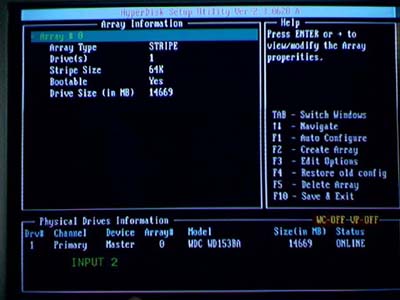
Even for users with only one ATA-100 hard drive, they can use the RAID controller as two regular ATA-100 channels by disabling all RAID functions. Just like other motherboards with external ATA-100 IDE controllers, the HG80649 is represented as a SCSI controller in the BIOS setup, and users just need to choose SCSI as first boot device in order to boot with their ATA-100 hard drives.
Unfortunately for Iwill, the KV200-R comes at a poor time, since shipments of VIA’s 686B South Bridge are just starting to be seen on motherboards. The 686B South Bridge offers Ultra ATA-100 support as its only advantage over the 686A South Bridge on the KV200-R, essentially making the on-board AMI controller an added cost that, for many, won’t be worth it.
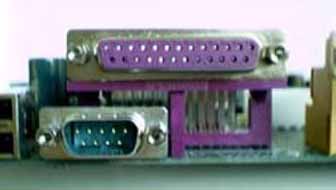
Another interesting thing to notice is the placement of the second serial port. Usually the two serial ports are both positioned on the back of the board in the I/O panel. However, for KV200-R, the second serial port is not there. This is probably a move by Iwill to provide a motherboard for the OEM market, where the OEM would choose to put in an on-board VGA connector or some sort of other interface in place of the second serial port. Instead, Iwill put the second connector on the left edge of the board and includes a 9-pin header with the KV200-R. However, Iwill failed to include a special I/O shield to cover up the “hole” caused by the missing serial port.
The Iwill KV200-R is using the popular Award Modular 6.00PGN BIOS. Iwill uses what they call the “Bye-Bye Jumper” Iwill Smart Settings, where users can select their desired FSB in the BIOS. The BIOS setup provides FSB settings between 100MHz and 166MHz, in 1MHz increments. From our experience, current chipset limitations prevents stability at most FSB frequencies higher than 110MHz, so settings higher than 110MHz are really not that useful. However, that still leaves quite a few FSB settings between 100MHz and 110MHz that can be used, so overclockers should be able to do quite a bit of FSB tweaking with the KV200-R.
In the BIOS, users can find the PC Health Status. From there users can get information on the CPU temperature, system temperature, and also the speed of the two fans. It also reports the voltage of the CPU, but it provides no information on the AGP voltage which is normal for most motherboards.
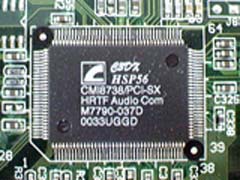 Iwill
uses the C-media CMI-8738 3D 4.1 PCI sound controller for the onboard sound,
which has a much better sound quality than the usual AC97 CODEC we’ve seen on
most KT133 based boards. The controller supports a 4.1 speaker setup (front/rear
+ subwoofer) and it uses a technology from CRL 3D Audio, the 32-voice HRTF-base
3D positional audio, which helps to position sound sources when using 4.1 speaker
systems. This technology supports Microsoft Direct Sound 3D and Aureal’s A3D
interfaces, so games and applications software that utilize these interfaces
will be able to take advantage of the HRTF 3D positional audio. For example
when playing a game with A3D support, sounds that physically occur behind your
character in the game will be produced more prominently from your rear speakers
in a 4.1 setup.
Iwill
uses the C-media CMI-8738 3D 4.1 PCI sound controller for the onboard sound,
which has a much better sound quality than the usual AC97 CODEC we’ve seen on
most KT133 based boards. The controller supports a 4.1 speaker setup (front/rear
+ subwoofer) and it uses a technology from CRL 3D Audio, the 32-voice HRTF-base
3D positional audio, which helps to position sound sources when using 4.1 speaker
systems. This technology supports Microsoft Direct Sound 3D and Aureal’s A3D
interfaces, so games and applications software that utilize these interfaces
will be able to take advantage of the HRTF 3D positional audio. For example
when playing a game with A3D support, sounds that physically occur behind your
character in the game will be produced more prominently from your rear speakers
in a 4.1 setup.
The onboard sound should be enough for users who just some decent, entry level 3D sound. However, for users who want only the best 3D sound quality, they will prefer to search for some other PCI sound cards such as a SoundBlaster Live!. For more information on Sound and Speakers, be sure to read our Speaker Buyer’s Guide as well as our growing collection of Sound and Speaker reviews.
One very noticeable feature of the Iwill KV200-R is the PhoenixNet support by Phoenix Technologies and AwardBIOS. The PhoenixNet Internet Launch System (ILS) is built into the BIOS firmware, and it will be installed together with your first install of Windows 98. Users can then use the program to connect to the Internet and log on to PhoenixNet free service. This can be useful for users who need guidance to the Internet, but for advanced users this might not be as useful. Moreover, since this software resides inside the BIOS, so the size limitation does not allow the software to be used in operating systems other than Windows 98.
Bundled with the KV200-R motherboard is a CD containing all the drivers and utilities, including all the software required for the C-Media onboard sound. Iwill also includes the PC-Cillin, an anti-virus program. There is also one diskette containing the ATA-100 RAID driver for Windows 2000 in case users will be installing from drives placed on the ATA-100 channels in which case you will have to inform Windows 2000 setup of the on-board AMI controller and provide the drivers on this disk before continuing with the install.
From the documentation perspective, the KV200-R’s 156-page manual is excellent. It contains all the information and diagrams regarding all jumpers and connectors, and has detail descriptions on every setting in the BIOS and regarding PhoenixNet. It also explains how RAID is set up on the KV200-R, as well as the utilities needed for the C-Media onboard sound.
The Bad
There are a few complaints we had against the motherboard, the biggest being the issue of stability. During our 24 hour Content Creation Winstone 2000 stability test, the KV200-R crashed for a total of 9 times, where as for other motherboards we have tested the average crash rate is about 6 to 7, with the best boards crashing no more than 1 or 2 times. It is important to note that not all the crashes are caused by the motherboard, since the operating system and software often contribute to a lot of the crashes. However, we try to isolate the motherboard as best as possible as the only cause of failures by keeping all other components and variables constant, so the number of crashes can be used for comparison.
The placement of the power supply connector once again caught our attention as not being ideally oriented towards the right hand side of the PCB.
It would also have been nice if Iwill had included the ability to change the multiplier of the CPU, something that ABIT and ASUS have done to allow more effective overclocking attempts. This absence will unfortunately keep the KV200-R out of the hands of many hardware enthusiasts.
As with most motherboard manufacturers, Iwill did not include the necessary cables to take advantage of the 2 extra USB connectors onboard, and it would definitely be something nice to have.
With the lack of support for the AMR specification, it’s disappointing to see Iwill place the sole AMR slot on the board in an unshared position, potentially sacrificing a PCI or ISA slot for this which is of much less use.
Finally, we would’ve liked to have seen Iwill provide a custom I/O shield that covered up the opening left by the missing second serial port.
USB Compatibility
· Number of Front Universal Serial Bus Root Ports: 2
· Number of Rear Universal Serial Bus Root Ports: 2
· USB IRQ Enable/Disable in BIOS: Yes
· USB Keyboard Support in BIOS: Yes
Recommended SDRAM
Recommended SDRAM: 1 x 128MB Corsair PC133 SDRAM; 1 x 128MB Mushkin PC133 SDRAM
SDRAM Tested: 1 x 128MB Mushkin PC133 SDRAM
Manufacturer: Corsair
Purchase Website: http://www.corsairmicro.com
Manufacturer: Mushkin
Purchase Website: http://www.mushkin.com
The Test
In recent times, choosing a motherboard cannot be completely determined by a Winstone score. Now, many boards come within one Winstone point of each other and therefore the need to benchmark boards against each other falls. Therefore you should not base your decision entirely on the benchmarks you see here, but also on the technical features and advantages of this particular board, seeing as that will probably make the greatest difference in your overall experience.
Click Here to learn about AnandTech's Motherboard Testing Methodology.
|
Test Configuration |
|
| Processor(s): |
AMD
Athlon (Thunderbird) 800MHz
|
| RAM: |
1 x 128MB Mushkin PC133 SDRAM
|
| Hard Drive(s): |
Western Digital 153BA Ultra
ATA 66 7200 RPM
|
| Bus Master Drivers: |
VIA 4-in-1 v4.24 Service
Pack
|
| Video Card(s): |
NVIDIA
GeForce 2 GTS 32MB DDR
|
| Video Drivers: |
NVIDIA
Detonator 5.22
|
| Operation System(s): |
Windows
98 SE
|
| Motherboard Revision: |
Iwill KV200-R Revision 1.1
|
|
Windows 98 Performance |
|||
|
Athlon
800 (KT133)
|
Sysmark
2000
|
Content
Creation
Winstone 2000 |
Quake
III Arena - 640 x 480 x 16
|
| Iwill KV200-R |
160
|
32.9
|
123.9
|
| Microstar K7T Master |
161
|
32.7
|
123.7
|
| Soyo SY-K7VTA |
160
|
27.5
|
127.0
|
Final Words
The Iwill KV200-R performs fairly well in our tests, however, it is not as stable as some of the other Socket-A KT133 motherboards we’ve seen.
The KV200-R is fairly feature rich, with support for ATA-100 and IDE RAID, as well as the unique PheonixNet service, unfortunately the latter will be of little use to most advanced users.
In the end, the KV200-R is a solid attempt by Iwill as their first entry into the Athlon motherboard market, however with the presence of solutions such as the ABIT KT7-RAID, the ASUS A7V and the Microstar K7T Pro, the KV200-R will find it very hard to compete.
How it Rates
|
AnandTech Motherboard Rating |
|
|
Rating
(x/10)
|
|
|
Performance
|
5.5
|
|
Price
|
5.5
|
|
Stability
|
4.5
|
|
Quality
|
5.5
|
|
Features
|
6.0
|
|
Layout
|
4.5
|
|
Availability
|
7.5
|
|
Documentation & Software Bundle
|
7.0
|
| Overall Rating - not an average Click here to find out why |
6.0
|

